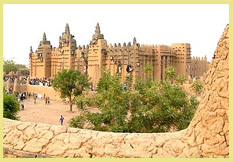




Island of Mozambique - Mozambique

Website Category: European Colonial Influences
Area: unknown
Inscribed: 1991
Criteria: (iv) icon of an era (vi) association with belief system
Location and Values: The Island of Mozambique is located in northern Mozambique, near the port of Nacala. It is approximately 2.5 km long and 300 m wide and connected to the mainland by a 1.5 km-long causeway. Discovered by the Portuguese explorer Vasco da Gama in 1498, it became an important port-of-call on the sea route to India. A Portuguese fort was established here in 1507, and work on a much bigger one, Fort St Sebastian was begun in 1558. Mozambique Island grew in importance, serving as the capital of the Portuguese colony of Mozambique until it was moved to Maputo in 1898. The fort remains the island’s single most important historical monument, but the ensemble of Portuguese colonial architecture that constitutes the stone-built (northern) half of the island testifies to the historical importance of the island for more than 400 years.
Slideshow of the Island Of Mozambique:
Slideshow Description of the Island Of Mozambique: The slideshow is one of the most extensive in this world heritage site collection, featuring 75 photos. It begins with the small Chapel of Nossa Senhora do Baluarte, the oldest European building in the southern hemisphere (built in 1522). The Chapel is now incorporated into the fortifications of the enormous Fort San Sebastian. Most of the photos show buildings and features of the ‘permanent’ stone-built town of the Portuguese, which occupies the northern half of the island, including the governor’s Palace, the Church of Misericordia, the old customs house and hospital. There are also pictures of the more temporary makuti (palm-thatch) structures of the southern sector, as well as scenes of contemporary life, local people and their boats.
Google Earth View: To view satellite imagery of the Island of Mozambique on Google Earth, click here. This opens a new window, so when you are finished, just close the Google Earth page and you will be straight back here to continue browsing other world heritage sites around Africa.

Mozambique Island Official Visitor Guide & History: A lavishly illustrated visitor guide, explaining the history and present-day sights of Mozambique Island, produced by Mozambique's Ministry of Education and Culture (with support from the Government of Portugal) can be downloaded by clicking here. The Visitor Guide includes interesting maps, comparing the island in its early years as a Portuguese settlement (in 1754) with the layout, buildings and monuments seen today.
Links to other places featuring European colonial influences: Kunta Kinteh I Ghana Forts I Fort Jesus I Essaouira I Mazagan I Goree I Saint-Louis I Robben Island I Cidade Velha I Asmara Modernist City
Other Links: Official UNESCO Site Details I World Monuments Fund




.jpg)